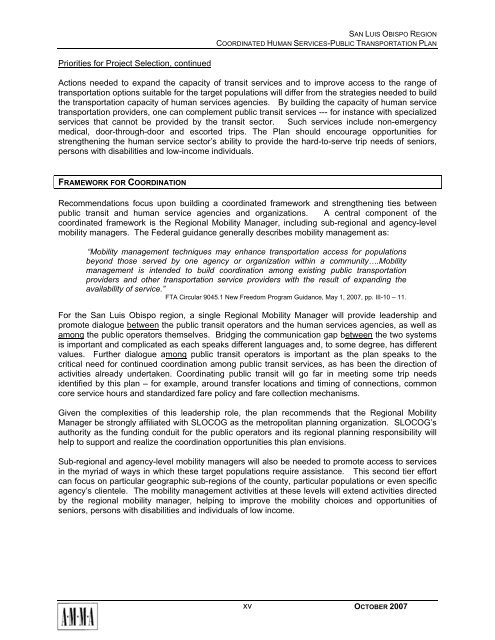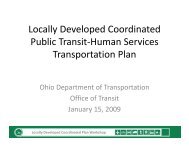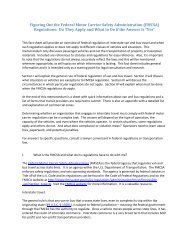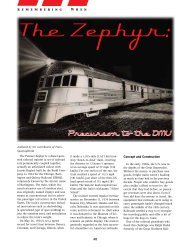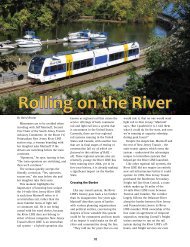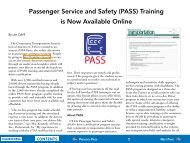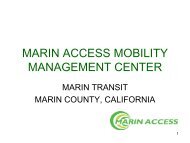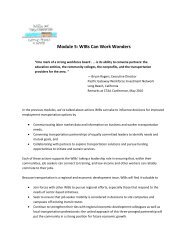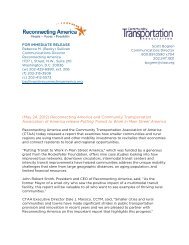San Luis Obispo - Caltrans - State of California
San Luis Obispo - Caltrans - State of California
San Luis Obispo - Caltrans - State of California
Create successful ePaper yourself
Turn your PDF publications into a flip-book with our unique Google optimized e-Paper software.
SAN LUIS OBISPO REGION<br />
COORDINATED HUMAN SERVICES-PUBLIC TRANSPORTATION PLAN<br />
Priorities for Project Selection, continued<br />
Actions needed to expand the capacity <strong>of</strong> transit services and to improve access to the range <strong>of</strong><br />
transportation options suitable for the target populations will differ from the strategies needed to build<br />
the transportation capacity <strong>of</strong> human services agencies. By building the capacity <strong>of</strong> human service<br />
transportation providers, one can complement public transit services --- for instance with specialized<br />
services that cannot be provided by the transit sector. Such services include non-emergency<br />
medical, door-through-door and escorted trips. The Plan should encourage opportunities for<br />
strengthening the human service sector’s ability to provide the hard-to-serve trip needs <strong>of</strong> seniors,<br />
persons with disabilities and low-income individuals.<br />
FRAMEWORK FOR COORDINATION<br />
Recommendations focus upon building a coordinated framework and strengthening ties between<br />
public transit and human service agencies and organizations. A central component <strong>of</strong> the<br />
coordinated framework is the Regional Mobility Manager, including sub-regional and agency-level<br />
mobility managers. The Federal guidance generally describes mobility management as:<br />
“Mobility management techniques may enhance transportation access for populations<br />
beyond those served by one agency or organization within a community….Mobility<br />
management is intended to build coordination among existing public transportation<br />
providers and other transportation service providers with the result <strong>of</strong> expanding the<br />
availability <strong>of</strong> service.”<br />
FTA Circular 9045.1 New Freedom Program Guidance, May 1, 2007, pp. III-10 – 11.<br />
For the <strong>San</strong> <strong>Luis</strong> <strong>Obispo</strong> region, a single Regional Mobility Manager will provide leadership and<br />
promote dialogue between the public transit operators and the human services agencies, as well as<br />
among the public operators themselves. Bridging the communication gap between the two systems<br />
is important and complicated as each speaks different languages and, to some degree, has different<br />
values. Further dialogue among public transit operators is important as the plan speaks to the<br />
critical need for continued coordination among public transit services, as has been the direction <strong>of</strong><br />
activities already undertaken. Coordinating public transit will go far in meeting some trip needs<br />
identified by this plan – for example, around transfer locations and timing <strong>of</strong> connections, common<br />
core service hours and standardized fare policy and fare collection mechanisms.<br />
Given the complexities <strong>of</strong> this leadership role, the plan recommends that the Regional Mobility<br />
Manager be strongly affiliated with SLOCOG as the metropolitan planning organization. SLOCOG’s<br />
authority as the funding conduit for the public operators and its regional planning responsibility will<br />
help to support and realize the coordination opportunities this plan envisions.<br />
Sub-regional and agency-level mobility managers will also be needed to promote access to services<br />
in the myriad <strong>of</strong> ways in which these target populations require assistance. This second tier effort<br />
can focus on particular geographic sub-regions <strong>of</strong> the county, particular populations or even specific<br />
agency’s clientele. The mobility management activities at these levels will extend activities directed<br />
by the regional mobility manager, helping to improve the mobility choices and opportunities <strong>of</strong><br />
seniors, persons with disabilities and individuals <strong>of</strong> low income.<br />
xv<br />
OCTOBER 2007


